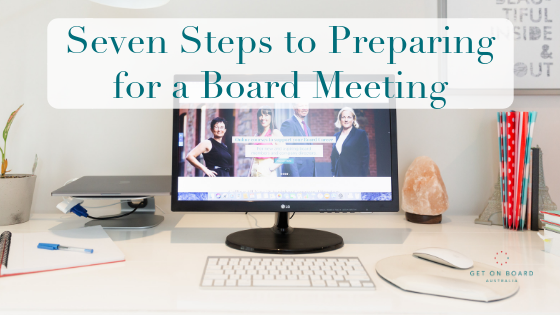How to Prepare for a Board Meeting

Sitting on many boards and committees has given me plenty of meeting preparation practice. I’ve made all the rookie mistakes and have left my preparation too late. It’s taken me time to get find a process that works for me and doesn’t leave me scurrying and stressing at the last minute. What I do know for sure is that proper planning and preparation prevents p**s poor performance.
The following steps should help you get to your meeting fully organised and prepared.
1. Leave yourself enough time to read through the board pack
Board packs can often be quite large. The size of your pack depends on how often the board meets, the length of the board meeting, the type of organisation, and what items need to be addressed and their complexity. Just last month I had a board pack that ran over 100 pages. This particular board meets every second month and that means there is usually a lot of content that needs covering. The benefit of the large board pack is that our meetings are generally shorter as we have received most of the required information prior to the board meeting.
You should receive your board pack at least one week in advance of the meeting (if you don’t, be sure to request it) and a good habit to get into is scheduling time in your calendar or diary for meeting preparation. With board meeting dates usually scheduled a year in advance, setting up a regular block of prep time should be easy. Pick a time that coincides with your best thinking time (mornings for me), and allows enough time for thorough reading, note-taking, thinking/contemplating, and requesting additional information prior to the meeting. My tip: overestimate the time required for this and work back from there.
2. Send questions and requests for additional information before the meeting
If you find something in the board pack that you feel requires additional information or clarification for you to make an informed and comfortable decision, send an email to the appropriate person (either the Chair/President or CEO or equivalent) with your query and the type of information or clarification you would like to receive. It’s courteous to follow this process and it makes for efficient meetings with prompt decisions.
3. Write any other questions down to ask during the meeting
If however you feel that your queries are not burdensome on the responsible person and can enhance everyone’s understanding during the board meeting, make a note of the question(s) in your meeting prep notes and ask them during the meeting. You should also ask questions there and then that come to your mind during the meeting. Again, keep notes on important information, discussions, questions, and answers that occur during the meeting. Don’t rely on board minutes as they usually only record the decision made (or not) and critical points of information.
4. If you’re presenting anything, ensure you run through exactly what you want to achieve and how you’ll achieve it
This could be anything from presenting a new policy that you want the board to adopt, to sharing feedback from a fundraising event you conducted. For new directors this process is nerve-wracking. Practice what you want to present and how you will present it. Take a look at this post about developing your boardroom presence to help you prepare and have a captive audience.
5. Set your intention for the meeting
This is a process that I have recently adopted; not just for board meetings, but for all of my meetings. Often times we just show up and go with the flow. This is great if the flow is good, positive, and heading in the right direction. In the boardroom this isn’t always the case, and sometimes our emotions get the better of us. It’s important to get your ‘head in the game’ and set an intention or goal for how you want to behave and/or achieve in the meeting. Having a word or mantra that you can repeat for when you’re starting to get worked-up (my go to: “Rise above. Stay calm. Be the leader.”), or your mind is wondering (“Be present.”) does wonders.
6. Show up and be present
Speaking about being present, when you attend your board meeting, be sure to be there 100%. Bring your whole self to the table. Be on time, remove distractions, engage in the discussions, listen fully, and contribute in a constructive way. It’s your responsibility as a director to discharge your duties effectively and a good practice to adopt is to take notes during the meeting. This is a simple way to keep you in the moment and concentrating on the meeting.
For a crash course on what not to do in a meeting, check out this list of ten annoying meeting behaviours.
7. Develop a process and stick with it
The best piece of advice I can give from my experience is to develop your own process. One that enables you to effectively and efficiently comply with your duties and responsibilities as a company director, follows best-practice behaviours, and leads to you being seen as a valuable board member. Once you have that process, stick to it!
The tips here can be used for any meeting, whether it’s for a board meeting or a committee meeting. Remember, it’s all in the preparation.
How do you prepare for your board meetings?

1 Comment
Comments are closed.